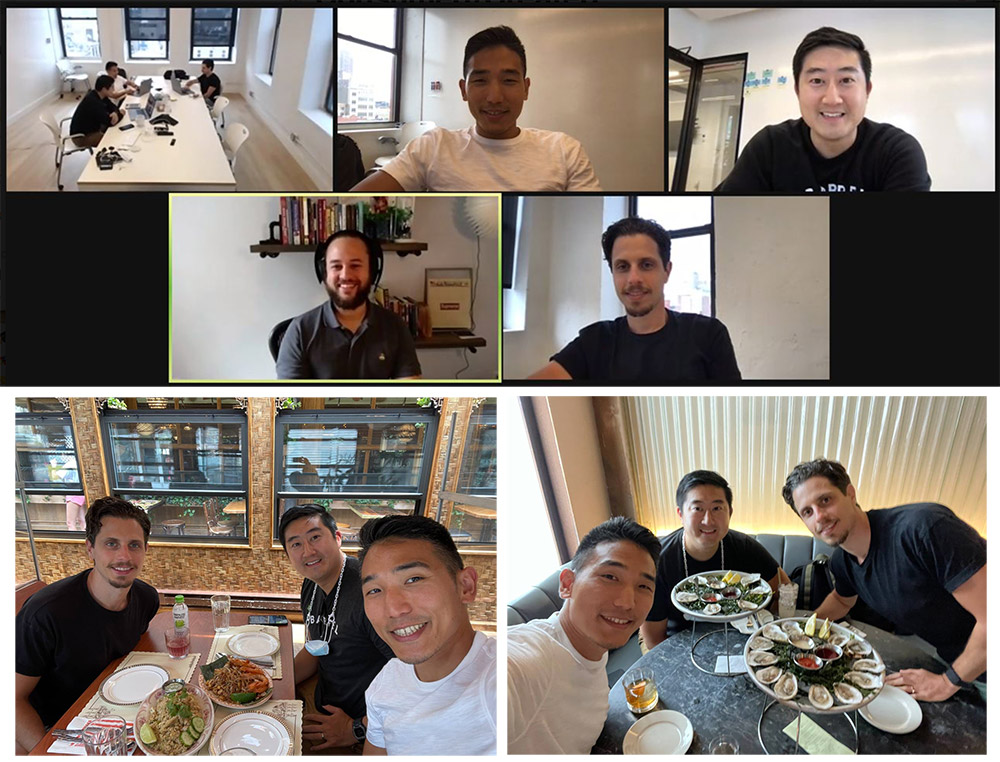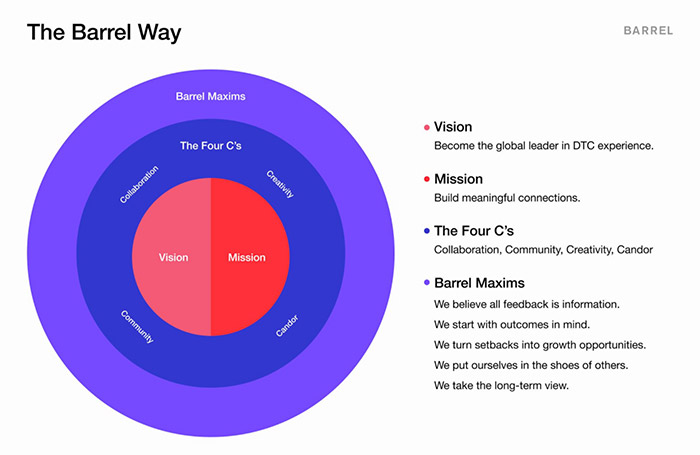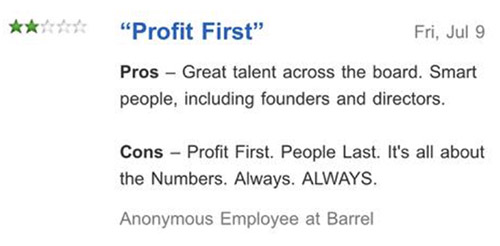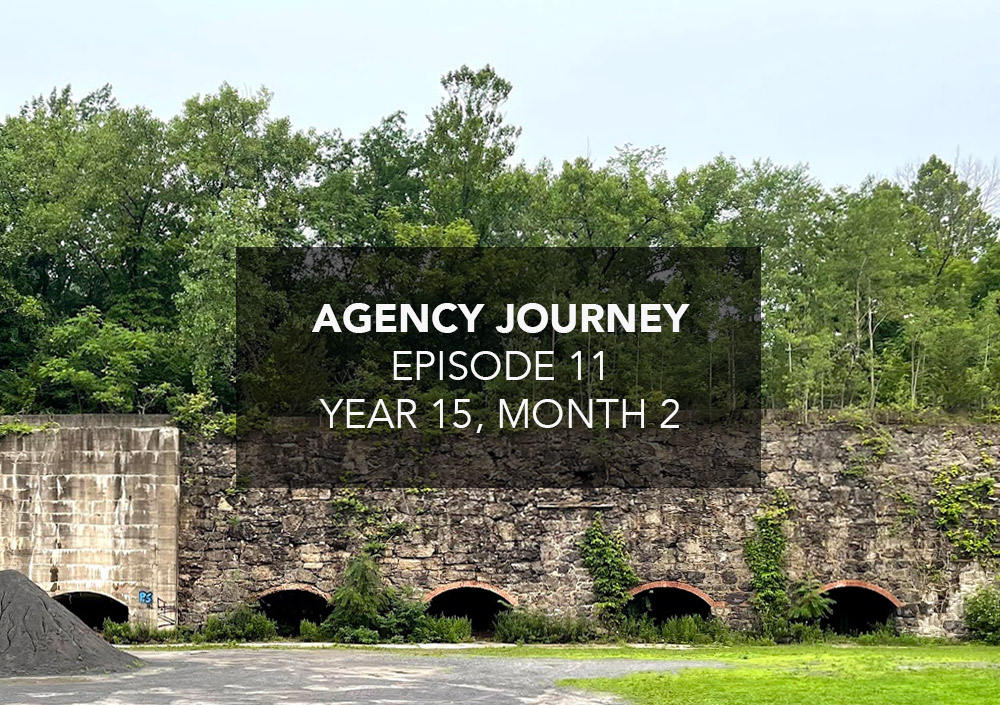I’m writing this after a full week away from work. My family took a trip a few hours north and stayed at an Airbnb, exploring the local towns and parks. While a vacation with two young children–especially with one who’s going through a sleep regression–wasn’t necessarily relaxing, I enjoyed the opportunity to take my mind off of work and to create some nice memories. Additionally, it was very rewarding to know that the business was making a great deal of progress on many fronts while I was out and that my absence didn’t slow anything down.
About Agency Journey: This is a monthly series detailing the happenings of my agency Barrel, founded in 2006. You can find previous episodes here.
Highlights
In-Person Partner Planning Meeting
For the first time since January 2020, we were able to meet in person for our quarterly Partner Planning Meeting. Our CTO Wes was unable to make it up from Atlanta, GA, but my co-founder Sei-Wook, who had just moved back to the East Coast from Los Angeles, and our CXO Lucas, were able to meet up at the Barrel Office for an all-day session.

Sei-Wook, Lucas, and I were able to meet in person at the Barrel Office in NYC. We still used Zoom to loop Wes in from Atlanta. We enjoyed Thai for lunch and had cocktails with oysters afterwards, getting the most out of our day in Manhattan.
We situated ourselves in one of our larger conference rooms and had a productive day of discussions. The first part of the meeting was centered on our reading of the book The Path of Least Resistance (see my blog post on Transformative Books We Read Together as a Leadership Team for details). The second part of the day was a visioning workshop, where we came prepared with detailed visions for three scenarios as described to each other 1 year later. Scenario 1 was about having an off-site retreat and what that was like, Scenario 2 was about how the business functioned and looked if we hit our gross profit margin goals, and Scenario 3 was a wild card ambitious project that we wanted to take on.
This was one of my favorite planning meetings of all time because the future-based language that we employed throughout the day was incredibly energizing and inspiring. Rather than dwell on pressing problems or any immediate threats to the business, we instead brought a wealth of new ideas through storytelling the future we envisioned for ourselves, our team, and the business.
Mid-Year Reflections
I penned a Mid-Year Letter to our team sharing our progress for the first 6 months of the year. The letter highlighted project launches, new client wins, new hires, and a number of process improvements, initiatives, and team events that took place. It felt good to list all these things down and share with the team.
With a number of new folks joining in the past couple of months, the letter was also intended to catch them up on things they weren’t here for and to highlight the progress we’ve made as an organization this year. While the year got off to a rocky start in terms of profitability, we’ve been able to course-correct and are trending to finish with our best performance ever–I think 35-40% topline year-over-year revenue growth for us is very possible as well as strong year-over-year gains in profit. We already surpassed all of last year’s bookings just 6.5 months into the year.
The letter also outlined our priorities for the months ahead, primarily focused on our hiring needs to keep up with new work and to replace folks who’ve left. We also have a number of key leadership roles that, once filled, will have great impact on the organization.
Speaking of folks who left, we’ve seen a wave of departures in the past few months. After nearly a year of minimal turnover, we’ve seen a sizable amount of attrition with folks finding new opportunities elsewhere. Some departures were unexpected while some were inevitable given some of the structural changes we’ve made recently. There was helpful feedback from all of the exit interviews, and we’ll be sure to keep improving different aspects of our business and team member experience to ensure retention.
Barrel Maxims
We’ve been looking to codify a handful of memorable maxims that capture key Barrel behaviors that are supported by our new mission, vision, and core values. We sent around a survey to get input from the team (about 50% of the team participated) and received some great ideas. Some recurring themes emerged and we were able to distill various options down to 5 maxims:
- All feedback is information.
With our core value of Candor, we believe in open and honest two-way communication. Whether or not we agree with the feedback, we will always make space to accept the feedback as information that can open new opportunities to reflect and grow. - Start with outcomes in mind.
We set ourselves up for success by taking the time to set a vision and fully understand what we want to achieve. We work to align on outcomes with our team members and clients because this means we’re helping each other advance in the same direction. - Turn setbacks into growth opportunities.
Every mistake or setback opens the door for us to learn and get better. We avoid assigning blame and pointing fingers when things go wrong. Instead, we look ahead at how we can do better the next time, what systems we can build, and how we can share this knowledge with others. - Put ourselves in the shoes of others.
Whether it’s a team member, client, our clients’ customers, contractor, or anyone else, we pause and imagine what they’re thinking and how they might be feeling before we react or pass judgment. When possible, we ask questions and listen actively, always seeking to understand. - Take the long-term view.
We invest and build for the long-term with the understanding that short-term solves and shortcuts don’t fully address underlying issues or create sustainable outcomes. We don’t let the stresses of the immediate situation pressure us into making short-term compromises that may weigh us down in the long run.

To introduce our new maxims, we created a diagram that showed how the maxims supported the core values, mission, and vision. (h/t to Lucas for making this)
To introduce the maxims to the team, we came up with a visual, called “The Barrel Way”, to show how these lived in relation to our mission, vision, and core values. We included this in our email, and we’ve started to find ways to slip maxims into our daily discourse. Fortunately, we’re already accustomed to saying similar things regularly in conversations, so I don’t think it’ll take much effort for the maxims to be regularly used throughout the organization.
Top of Mind
All Feedback is Information
Going off the maxims above, I thought it’d be instructive (for myself mostly) to highlight a story a Glassdoor review that popped up a few weeks ago:

There used to be a time when a negative Glassdoor review felt like a gut-punch to the stomach and my mood would be ruined for an entire day if not the entire week. Thankfully, those days are long gone and instead, the Barrel partners welcome all feedback, even ones that, on initial reading, seem very pointed and critical.
In the case of this particular feedback, we tried to put ourselves in the shoes of the reviewer and imagine what behaviors, signals, and communications on our end could have led to such a posting. The drawback of anonymous feedback is that we can be totally off about context and the reasons we come up with may not be at all what motivated the review in the first place, but I think the mere act of pausing to reflect on feedback can be valuable.
For this particular piece on “Profit First”, we landed on a few observations:
- Last year, we rolled out our Profit Sharing program. As part of the effort, we looked to increase the business literacy of the team, spending time during our Town Hall and Monthly Team Meetings to describe concepts like gross profit margins and our revenue targets. The thinking was that if everyone was on the same page about how we tracked the team’s financial performance, it would help them feel more invested in the Profit Sharing program. In hindsight, I can see how this emphasis on the financial side of things could have seen to team members unaccustomed to hearing about numbers and targets.
- Another area where perhaps our language around profit may have made a negative impression is around our practice of tracking project health. We used to have a spreadsheet that tracked the profit of all projects and could be filtered by the Producer assigned. The list could then be ordered from highest aggregate profit to lowest aggregate profit. This “leaderboard” view was short-lived and was retired when we received feedback that it caused anxiety among team members. We would eventually roll out a different Google Sheets-based app that calculated profits based on data from Harvest and SmartSheet. We asked Producers to carefully review this on a weekly basis to keep projects on track. This, too, in hindsight, may have overemphasized our focus on profits.
- One of the challenges we’ve worked hard to overcome in the past year is the continual feeling that we’re understaffed and under-resourced on projects. The biggest solve has been on the business development front where we’ve dramatically tightened our qualification process, taking on higher budget projects and reducing the overall project load on the team. The second piece has been to improve our recruiting function–we simply could not recruit, vet, and hire fast enough to meet demand, so we brought in a Talent Acquisition Manager to assist our various hiring managers. The road to get here hasn’t been easy and we’re still not totally in the clear, so I can understand if the team, regardless of how we’ve explained the situation, feels like we’ve held back on hiring and overburdened the team. When we don’t act fast enough and deliver results, the intentions don’t matter–people will get frustrated and feel that management is putting “people last”.
- Lastly, we were trying to zero in on the phrase “Profit First” because that carries a very particular meaning for us. After reading the book Profit First by Mike Michalowicz, Sei-Wook and I decided to adopt the system for our business and have run our finances in the manner recommended in the book. Part of this is a biweekly calculation on the 10th and 25th of the month where we figure out how much to pay ourselves as owners based on payments received as well as how much to put aside as “profit”. On Sei-Wook’s calendar, which is visible to the team, he has recurring events on the 10th and 25th of every month to do these calculations labeled “Profit First”. Putting myself in an employee’s shoes, if I had never heard of the Profit First method and nobody ever shared what it was but saw that one of the company’s owners had two recurring calendar events with that label, could I possibly assume that the owners only cared a great deal about profits? Taken out of context, it’s not hard to see that “Profit First” is a terrible label, especially when we’ve tried in so many different ways to talk about our Team Member Experience, career development, investing in talent, etc. “Cool they’re doing this and that, but ultimately, they only care about profit first.” It’s unfortunate if this is the case (and it could be that the person who wrote the review never saw this at all) and a reflection that we can always improve as leaders. For now, the easy fix is to change the calendar event label.
Ideally, we’re able to get direct feedback from team members with full context so we can more effectively address or answer concerns and issues. But I know this will take time and continual effort to build that trust company-wide. In the meantime, any feedback is useful, even if it’s aired out in public for all the world to see.
Additional reading: nearly 7 years ago, I wrote about receiving some negative Glassdoor reviews and wrote a response. It’s interesting to revisit and see how I handled criticism back then.
Shared with Partners
“Innovation is less about producing something new and more about enabling something new and important for customers.” (Clayton M. Christensen, Taddy Hall, Karen Dillon, David S. Duncan, Competing Against Luck)
I love this perspective on innovation. Oftentimes, we’re drawn to shiny new technologies and promises of a very cool future, quick to latch on to trendy jargon in order to feel “innovative”. What we can’t lose sight of is the fact that innovation is about making the lives of our customers easier and of delivering value that helps them achieve progress. There are so many forms this can take, and it doesn’t always have to involve shiny new tech.
“Your people environment is composed of three groups: the people you are in business with (your team, your company, and other agents); the people you do business with (your clients and vendors); and the people outside your business (your family and friends). What most fail to realize is that you are the gatekeeper and you can control who you let into your world, thus becoming an architect of your people environment.” (Gary Keller, Jay Papasan, Dave Jenks, Gary Keller, Dave Jenks, The Millionaire Real Estate Agent)
I like this concept of “people environment” and the power we have to shape it. It’s always energizing to connect and collaborate with people who’re continually learning, expanding their horizons, and being creative in their own ways. At the same time, I also value the comfort and support of those I’ve known a long time, appreciate their loyalty, and relax in knowing I have nothing to prove about myself to them. It’s a continual game of curation and exploration, one that we as social animals ought to embrace.
“Mastery of creative tension transforms the way one views “failure.” Failure is, simply, a shortfall, evidence of the gap between vision and current reality. Failure is an opportunity for learning—about inaccurate pictures of current reality, about strategies that didn’t work as expected, about the clarity of the vision. Failures are not about our unworthiness or powerlessness.” (Peter M. Senge, The Fifth Discipline)
On a long enough time horizon, provided we take the above advice to heart, all failures are just stepping stones towards the realization of a grand vision. The important thing is to have that vision in place and to be relentless about opportunities to learn.
